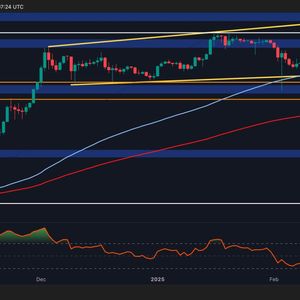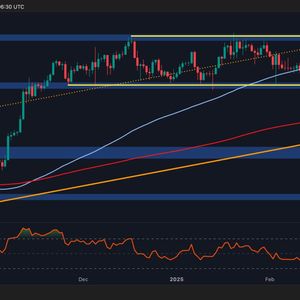Is the Indian financial system showing signs of strain? Whispers of a potential liquidity crunch are growing louder, prompting speculation about whether the Reserve Bank of India (RBI) will step in with a massive ₹1 trillion injection. For those navigating the volatile world of cryptocurrencies, understanding these macroeconomic shifts is crucial. A stable financial system is the bedrock upon which all markets, including crypto, operate. So, what’s really happening, and what could this mean for your crypto portfolio? Let’s dive deep into the heart of India’s liquidity landscape. Decoding the Looming Liquidity Gap in India First things first, what exactly is a liquidity gap ? In simple terms, it’s like a cash flow problem for the entire financial system. Banks and financial institutions need funds to operate smoothly – to lend to businesses, meet customer withdrawals, and manage their day-to-day operations. When there’s a mismatch between the demand for funds and the readily available cash, a liquidity gap emerges. Think of it as the financial arteries of the economy not having enough ‘blood’ to circulate efficiently. Several factors can contribute to this situation in India: Increased Credit Demand: As the economy aims for growth, businesses and individuals seek more loans, increasing the demand for liquidity in the banking system. Government Borrowing: Large government borrowing programs can sometimes crowd out liquidity from the market. Forex Outflows: Global economic uncertainties or attractive investment opportunities elsewhere can lead to foreign investors pulling out funds, reducing Rupee liquidity. Seasonal Factors: Festive seasons or agricultural cycles can also influence liquidity demand and availability. Global Economic Headwinds: International events, like rising interest rates in developed economies, can impact capital flows and domestic liquidity conditions. Currently, there are indications that the Indian financial system might be experiencing some tightening. While not a crisis yet, certain indicators suggest a need for proactive measures. This is where the RBI, the central bank of India, comes into the picture. Why is a ₹1 Trillion RBI Liquidity Injection on the Cards? The RBI acts as the lender of last resort for the Indian financial system. Its primary mandate is to maintain monetary stability and ensure smooth credit flow in the economy. When signs of a significant liquidity gap India emerge, the RBI has several tools at its disposal to inject liquidity and ease the pressure. A ₹1 trillion injection is a substantial amount, signaling that the perceived gap might be significant enough to warrant such a strong response. But why this potential urgency? Here’s a breakdown of the possible reasons: Preventing a Credit Crunch: A persistent liquidity gap can lead to banks becoming hesitant to lend, fearing their own funding shortages. This can stifle economic activity, particularly for businesses reliant on credit. Maintaining Financial Stability: A stressed financial system liquidity situation can create volatility and uncertainty in the markets, impacting investor confidence and overall economic sentiment. Supporting Economic Growth: Adequate liquidity is essential for businesses to invest, expand, and create jobs. Injecting liquidity can be a pre-emptive measure to support the ongoing economic recovery and growth aspirations. Managing Interest Rates: Liquidity conditions directly impact interest rates. A tight liquidity situation can push up borrowing costs, which can be detrimental to businesses and consumers. RBI aims to keep interest rates within a desired band to manage inflation and growth. The proposed ₹1 trillion injection isn’t just a random number. It’s likely based on careful assessments of the current liquidity situation, future projections, and the desired impact on the Indian economy liquidity conditions. How Does the RBI Plan to Boost Rupee Liquidity ? The RBI has various instruments to inject liquidity into the system. The most common methods include: Repo Operations: The RBI lends money to banks against government securities through repurchase agreements (repos). By increasing repo operations or easing repo terms, the RBI can inject liquidity. Open Market Operations (OMOs): The RBI can directly purchase government securities from the market. This injects cash into the system, increasing overall liquidity. Forex Swaps: The RBI can engage in foreign exchange swaps, buying Rupees against US dollars. This also increases Rupee liquidity in the market. Reducing Cash Reserve Ratio (CRR): CRR is the percentage of deposits banks must keep with the RBI. Reducing CRR frees up more funds for banks to lend, increasing liquidity. (Less likely in this scenario as CRR is already at a relatively low level). The specific method the RBI chooses will depend on the prevailing market conditions and the desired outcome. It’s likely to be a combination of these tools, strategically deployed to achieve the targeted liquidity boost . Potential Benefits of a Large Liquidity Injection A well-timed and effective liquidity injection can bring several benefits to the Indian economy: Benefit Description Eased Funding Costs Increased liquidity can lower borrowing costs for banks, which can translate to lower interest rates for businesses and consumers, stimulating economic activity. Improved Credit Availability Banks become more willing to lend when they have ample liquidity, ensuring businesses have access to the capital they need for growth and expansion. Market Stability Adequate liquidity can reduce volatility in financial markets and prevent sudden sharp movements in interest rates or asset prices. Support for Economic Growth By ensuring smooth credit flow and lower borrowing costs, liquidity injection can act as a catalyst for economic growth and investment. Enhanced Investor Confidence A proactive approach by the RBI to address liquidity concerns can boost investor confidence in the Indian financial system and economy. Navigating the Challenges and Potential Risks While a liquidity injection is generally seen as a positive measure in times of stress, it’s not without its potential challenges and risks: Inflationary Pressures: Injecting too much liquidity can fuel inflation if not managed carefully. Increased money supply can lead to higher prices if demand outstrips supply. The RBI needs to calibrate the injection carefully to avoid unintended inflationary consequences. Moral Hazard: Frequent liquidity injections might create a ‘moral hazard’ where banks become overly reliant on RBI support and take on excessive risks, knowing the central bank will always be there to bail them out. Effectiveness Concerns: There’s no guarantee that a liquidity injection will always translate into increased lending and economic activity. If underlying demand is weak or businesses are hesitant to invest due to other factors, the impact might be limited. Currency Depreciation: In some cases, large liquidity injections can lead to a depreciation of the domestic currency if not managed in conjunction with other monetary policy tools. The RBI is well aware of these risks and will likely implement the liquidity injection in a measured and strategic manner, closely monitoring its impact and taking corrective actions if needed. Impact on the Cryptocurrency Market in India: A Ripple Effect? While the RBI’s liquidity injection is primarily aimed at the broader financial system, it can indirectly impact the cryptocurrency market in India. Here’s how: Improved Investor Sentiment: A stable and well-functioning financial system generally boosts overall investor sentiment. Positive sentiment can spill over into the cryptocurrency market, encouraging more participation and investment. Rupee Stability: Effective liquidity management by the RBI can contribute to the stability of the Indian Rupee. A stable Rupee reduces volatility and uncertainty for crypto investors trading in INR pairs. Economic Confidence: A healthy and liquid financial system reflects positively on the overall economic health of the country. Increased economic confidence can lead to greater risk appetite among investors, potentially benefiting asset classes like cryptocurrencies. Indirect Liquidity Flows: While not directly related, improved liquidity in the traditional financial system can sometimes indirectly facilitate smoother on-ramps and off-ramps for crypto exchanges and investors. However, it’s crucial to remember that the cryptocurrency market is also influenced by a multitude of global factors, regulatory developments, and technological advancements. The RBI’s liquidity injection is just one piece of the puzzle. Actionable Insights: Staying Informed and Prepared For cryptocurrency enthusiasts and investors in India, staying informed about these macroeconomic developments is paramount. Here are some actionable insights: Monitor RBI Announcements: Keep an eye on RBI press releases and policy statements regarding liquidity management and monetary policy. Track Key Economic Indicators: Follow indicators like inflation, GDP growth, credit growth, and forex reserves to understand the broader economic context. Analyze Market Liquidity Data: Pay attention to indicators of interbank lending rates and liquidity conditions in the money markets. Diversify Your Portfolio: Macroeconomic uncertainties highlight the importance of portfolio diversification. Don’t put all your eggs in one basket, whether it’s crypto or any other asset class. Stay Updated on Crypto Regulations: Keep abreast of regulatory developments in the cryptocurrency space in India, as these can have a more direct impact on the market. Conclusion: Navigating the Liquidity Landscape The potential ₹1 trillion RBI liquidity injection is a significant development that underscores the importance of maintaining a healthy and liquid financial system in India. While it’s a proactive measure to address a potential liquidity gap and support the Indian economy liquidity , it also highlights the complexities of macroeconomic management. For cryptocurrency enthusiasts, understanding these broader economic currents is essential. A stable and growing Indian economy provides a more conducive environment for all markets, including the dynamic world of cryptocurrencies. By staying informed and adaptable, investors can navigate these evolving landscapes and make informed decisions. To learn more about the latest Forex market trends, explore our articles on key developments shaping global currency dynamics and macro-economic trends.











